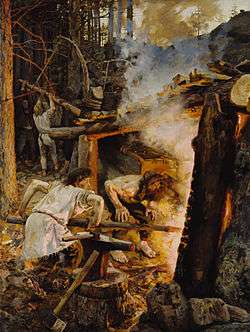Sampo
In Finnish mythology, the Sampo or Sammas was a magical artifact of indeterminate type constructed by Ilmarinen that brought good fortune to its holder. When the Sampo was stolen, it is said that Ilmarinen's homeland fell upon hard times and he sent an expedition to retrieve it, but in the ensuing battle it was smashed and lost at sea.
The Sampo has been interpreted in many ways: a world pillar or world tree, a compass or astrolabe, a chest containing a treasure, a Byzantine coin die, a decorated Vendel period shield, a Christian relic, etc. In the Kalevala, compiler Lönnrot interpreted it to be a quern or mill of some sort that made flour, salt, and gold out of thin air. The world pillar hypothesis, originally developed by historian of religions Uno Harva and the linguist Eemil Nestor Setälä in the early 20th century, is the most widely accepted one.[1]
According to Giorgio de Santillana, professor of the history of science at MIT, and student of mythology, the sampo and the world pillar both refer to the precession of the equinox. In Hamlet's Mill, co-authored with Hertha von Dechend, the authors find that the sampo or precession process was believed to grind out different world ages, from dark age to golden age and back again over the long precession cycle.
Description in the Kalevala

The Sampo is a pivotal element of the plot of the Finnish epic poem Kalevala, compiled in 1835 (and expanded in 1849) by Elias Lönnrot based on earlier Finnish oral tradition.
In the expanded second version of the poem, the Sampo is forged by Ilmarinen, a legendary smith, as a task set by the Mistress of Pohjola in return for her daughter's hand.
- "Ilmarinen, worthy brother,
- Thou the only skilful blacksmith,
- Go and see her wondrous beauty,
- See her gold and silver garments,
- See her robed in finest raiment,
- See her sitting on the rainbow,
- Walking on the clouds of purple.
- Forge for her the magic Sampo,
- Forge the lid in many colors,
- Thy reward shall be the virgin,
- Thou shalt win this bride of beauty;
- Go and bring the lovely maiden
- To thy home in Kalevala."[2]
Ilmarinen works for several days at a mighty forge until finally the Sampo is created:
- On one side the flour is grinding,
- On another salt is making,
- On a third is money forging,
- And the lid is many-colored.
- Well the Sampo grinds when finished,
- To and fro the lid in rocking,
- Grinds one measure at the day-break,
- Grinds a measure fit for eating,
- Grinds a second for the market,
- Grinds a third one for the store-house.[2]
Later, Louhi the sorceress steals the Sampo, provoking Ilmarinen and Väinämöinen to enter her stronghold in secret and retrieve it. Louhi, in reply, pursues them and combats Väinämöinen. In the struggle, Louhi is vanquished but the Sampo is destroyed.
Portrayal in film
In 1959 the joint Soviet-Finnish film production Sampo (titled The Day the Earth Froze when released in the United States) adapted the Kalevala to the big screen. Directed by Risto Orko and Aleksandr Ptushko, and written by Väinö Kaukonen and Viktor Vitkovich, the movie somewhat alters the circumstances surrounding the Sampo's creation; Louhi kidnaps Ilmarinen's sister Annikki to compel him to build a Sampo for her. However, the movie remains reasonably true to the original tale in broad outline, and the Sampo's fate is the same.
Episode 422 of Mystery Science Theater 3000, produced in the 1992–93 season, featured The Day the Earth Froze. Though the movie does explain what a Sampo is, the MST3K characters are talking during the explanation and miss it, and are therefore confused throughout the film as to what exactly a "Sampo" is, and argue about their own theories throughout the rest of the episode. In an about-face from the standard television practice, they request that viewers do not send fan mail detailing their theories as to what a Sampo might be. In Episode 506, "Eegah", they receive a letter from a fan which includes a photograph of a Sampo portable television set - Sampo Corporation is a Taiwanese electrical manufacturer that produces televisions, amongst other products.[3]
The Sampo is also being forged in the 2006 movie Jade Warrior. The movie is a Finnish-Chinese co-production and is loosely based on the Kalevala and includes Wuxia elements as well.
Similar devices
The Cornucopia of Greek mythology also produces endless goods.
Some versions of the Grail myth emphasize how the Grail creates food and goods.
The Mill Grótti of the Grottasöngr in Nordic mythology also produces gold (as well as peace and happiness) and salt.
Japanese folktale Shiofuki usu speaks of a grindstone that could be used to create anything. Like Sampo, it too was lost to the sea, endlessly grinding salt.
The Mahabharatha speaks about the Akshaya Pathram, a vessel/bowl capable of creating food. It stopped providing at the end of the day when the lady of the house had her last meal. This vessel was provided to the Pandavas, when in exile, by Krishna.
The sankara stone, sought by Indiana Jones and his comrades in Indiana Jones and the Temple of Doom, is essential to the wellbeing of the village from which it was taken.
The World Mill is a hypothesized mytheme shared by the mythologies of certain Indo-European-speaking peoples, involving the analogy of the cosmos or the firmament (Finnish: Taivaankansi) and a rotating millstone. The aforementioned Grótti is sometimes seen as an example of the mytheme.
See also
References
- ↑ http://www.websters-dictionary-online.com/definitions/Sampo?cx=partner-pub-0939450753529744%3Av0qd01-tdlq&cof=FORID%3A9&ie=UTF-8&q=Sampo&sa=Search#922
- 1 2 Kalevala, Rune X. Translated by John Martin Crawford (1888).
- ↑ dPlus. "SAMPO聲寶".
External links
| Wikimedia Commons has media related to Sampo (mythology). |
- Sampo at the Internet Movie Database
- Jade Warrior at the Internet Movie Database
- Finnish Literature Society's Kalevala site
